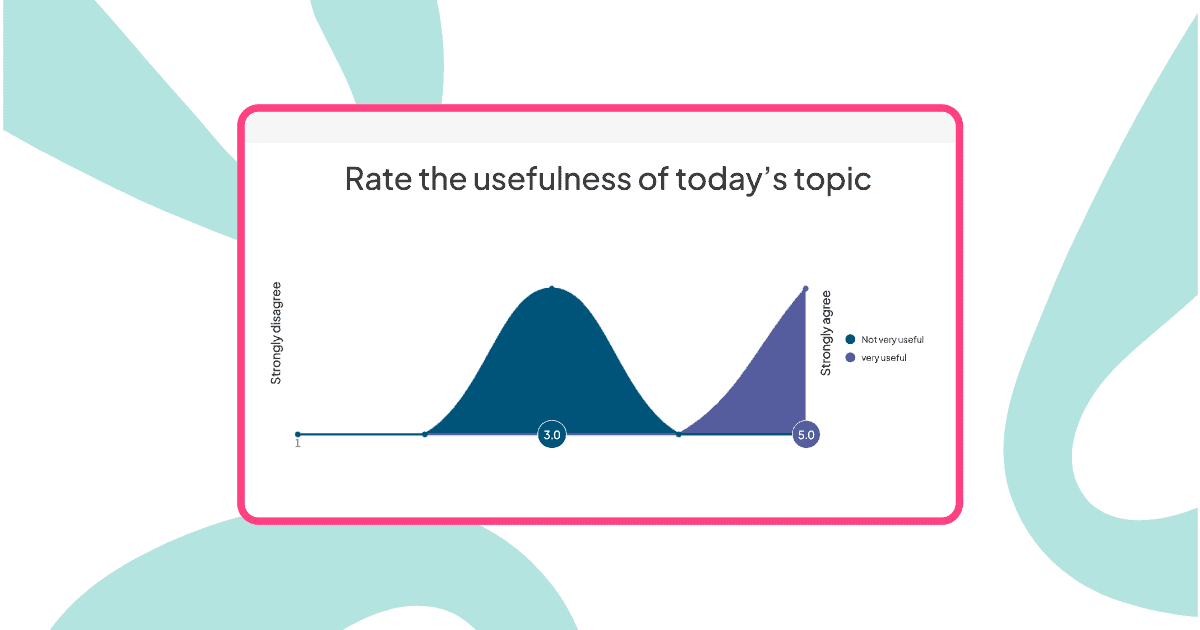Kas olete kunagi mõelnud, kuidas teie töötajad tegelikult oma rolli, panuse ja üldise tööga rahuloluga suhtuvad?
Rahuldav karjäär ei piirdu enam kuu lõpus saadava palgatšekiga. Kaugtöö, paindliku tööaja ja muutuvate tööülesannete ajastul on tööga rahulolu definitsioon dramaatiliselt muutunud.
Probleem on järgmine: traditsioonilised iga-aastased uuringud annavad sageli madala vastuse määra, hilinenud ülevaate ja desinfitseerimata vastused. Töötajad täidavad neid üksi oma laua taga, olles hetkest eemal ja kartes paljastamist. Tulemuste analüüsimise ajaks on probleemid kas eskaleerunud või unustatud.
On olemas parem viis. Meeskonnakoosolekutel, avalikel koosolekutel või koolitustel läbiviidavad interaktiivsed töörahulolu uuringud annavad autentset tagasisidet just siis, kui kaasatus on suurim ja saate muredele reaalajas lahendusi leida.
Selles juhendis pakume 46 näidisküsimust teie tööga rahulolu küsimustiku jaoks, näitavad teile, kuidas muuta staatilised küsitlused kaasahaaravateks vestlusteks ja aitavad teil luua töökohakultuuri, mis toetab töötajate kaasatust, ergutab innovatsiooni ja loob eeldused püsivaks eduks.
Sisukord
- Mis on tööga rahulolu küsimustik?
- Miks on vaja läbi viia tööga rahulolu küsitlus?
- Erinevus traditsiooniliste ja interaktiivsete küsitluste vahel
- 46 näidisküsimust tööga rahulolu küsimustiku jaoks
- Kuidas AhaSlidesiga läbi viia tõhus töörahulolu uuring
- Miks interaktiivsed küsitlused toimivad paremini kui traditsioonilised vormid
- Võtme tagasivõtmine
Mis on tööga rahulolu küsimustik?
Töörahulolu küsimustik, tuntud ka kui töötajate rahulolu uuring, on strateegiline tööriist, mida personalispetsialistid ja organisatsioonide juhid kasutavad, et mõista, kui rahulolevad nende töötajad oma rollides on.
See koosneb hoolikalt koostatud küsimustest, mis on loodud hõlmama olulisi valdkondi, sealhulgas töökeskkonda, tööülesandeid, suhteid kolleegide ja juhendajatega, töötasu, arenguvõimalusi, heaolu ja palju muud.
Traditsiooniline lähenemine: Saada küsitluse link laiali, oota vastuseid, analüüsi andmeid nädalaid hiljem ja seejärel rakenda muudatusi, mis tunduvad algsetest muredest lahus olevat.
Interaktiivne lähenemine: Esitage koosolekutel reaalajas küsimusi, koguge kohest tagasisidet anonüümsete küsitluste ja sõnapilvede kaudu, arutage tulemusi reaalajas ja töötage koos välja lahendusi, kuni vestlus on veel värske.
Miks on vaja läbi viia tööga rahulolu küsitlus?
Pew uurimistöö rõhutab, et ligi 39% mitte-füüsilisest isikust ettevõtjatest peab oma tööd oma üldise identiteedi seisukohalt ülioluliseks. Seda meelsust kujundavad sellised tegurid nagu pere sissetulek ja haridus, kusjuures 47% kõrgema sissetulekuga töötajatest ja 53% magistriõppe üliõpilastest peavad oma tööidentiteeti oluliseks. See koosmõju on töötajate rahulolu seisukohalt ülioluline, mistõttu on hästi struktureeritud tööga rahulolu küsimustik eesmärgi ja heaolu edendamiseks hädavajalik.
Töörahulolu küsitluse läbiviimine pakub olulisi eeliseid nii töötajatele kui ka organisatsioonile:
Sügavmõtteline mõistmine
Konkreetsed küsimused paljastavad töötajate tõelised tunded, paljastades arvamused, mured ja rahuloluvaldkonnad. Interaktiivselt läbi viidud anonüümsete vastusevõimalustega küsimuste korral väldite samastumise hirmu, mis traditsioonilistes uuringutes sageli ebaausa tagasiside andmiseni viib.
Probleemi tuvastamine
Sihipärased päringud tuvastavad moraali ja kaasatust mõjutavad valupunktid – olgu need seotud suhtlemise, töökoormuse või arenguvõimalustega. Reaalajas sõnapilved visualiseerivad koheselt, kus enamikul töötajatel raskusi on.
Kohandatud lahendused
Kogutud andmed võimaldavad pakkuda kohandatud lahendusi, mis näitavad teie pühendumust töötingimuste parandamisele. Kui töötajad näevad oma tagasisidet koheselt kuvatuna ja seda avatult arutatakse, tunnevad nad end tõeliselt kuuldavana, mitte ainult küsitletuna.
Suurem kaasatus ja klientide hoidmine
Küsimustiku tulemuste põhjal muredele vastamine suurendab kaasatust, aidates kaasa väiksemale voolavusele ja suuremale lojaalsusele. Interaktiivsed küsitlused muudavad tagasiside kogumise bürokraatlikust ülesandest sisukaks vestluseks.
Erinevus traditsiooniliste ja interaktiivsete küsitluste vahel
| Aspekt | Traditsiooniline uuring | Interaktiivne uuring (AhaSlides) |
|---|---|---|
| Ajastamine | Saadetud e-posti teel, täidetud üksi | Otseülekanne koosolekute ajal |
| Vastus kell | 30-40% keskmiselt | 85–95% otseülekande ajal |
| Anonüümsus | Küsitav – töötajad muretsevad jälgimise pärast | Tõeline anonüümsus ilma sisselogimiseta |
| tegevus | Tundub nagu kodutöö | Tundub nagu vestlus |
| Tulemused | Päevi või nädalaid hiljem | Kohene reaalajas visualiseerimine |
| tegevus | Viivitus, ühenduse katkemine | Kohene arutelu ja lahendused |
| vorming | Staatilised vormid | Dünaamilised küsitlused, sõnapilved, küsimused ja vastused, hinnangud |
Peamine arusaam: Inimesed on kaasatumad, kui tagasiside tundub pigem dialoogina kui dokumenteerimisena.
46 näidisküsimust tööga rahulolu küsimustiku jaoks
Siin on kategooriatesse jaotatud näidisküsimused. Igas osas on juhised, kuidas neid interaktiivselt esitada maksimaalse aususe ja kaasatuse saavutamiseks.
Töökeskkond
Küsimused:
- Kuidas hindaksite oma töökoha füüsilist mugavust ja ohutust?
- Kas olete rahul töökoha puhtuse ja korraldusega?
- Kas tunnete, et kontoriõhkkond soodustab positiivset töökultuuri?
- Kas teile on tagatud oma töö tõhusaks tegemiseks vajalikud tööriistad ja ressursid?
Interaktiivne lähenemine AhaSlidesiga:
- Kasutage reaalajas kuvatavaid hinnanguskaalasid (1–5 tärni)
- Jätka avatud sõnapilvega: "Kirjelda ühe sõnaga meie töökoha atmosfääri."
- Luba anonüümne režiim, et töötajad hindaksid füüsilisi tingimusi ausalt ja kartmatult
- Arutelu alustamiseks kuva kohe koondtulemused
Miks see töötab? Kui töötajad näevad, et teistel on sarnased mured (nt mitu inimest hindavad "tööriistu ja ressursse" hindega 2/5), tunnevad nad end õigustatuna ja on altimad järelküsimuste ja vastuste sessioonidel oma seisukohti täpsustama.
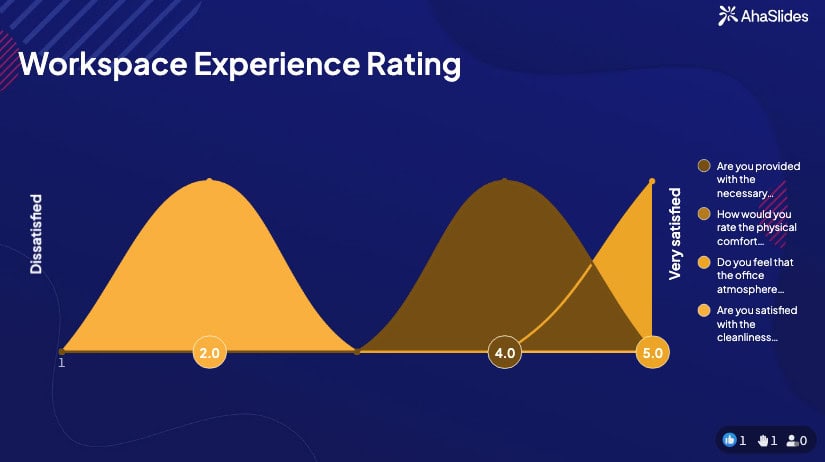
Proovige töökeskkonna küsitluse malli →
töö kohustused
Küsimused:
- Kas teie praegused töökohustused on kooskõlas teie oskuste ja kvalifikatsiooniga?
- Kas teie ülesanded on selgelt määratletud ja teile edastatud?
- Kas teil on võimalusi võtta vastu uusi väljakutseid ja täiendada oma oskusi?
- Kas olete rahul oma igapäevaste ülesannete mitmekesisuse ja keerukusega?
- Kas tunned, et sinu töö pakub eesmärki ja rahulolu?
- Kas olete rahul oma rollis antud otsustusõiguse tasemega?
- Kas teie arvates on teie tööülesanded kooskõlas organisatsiooni üldeesmärkide ja missiooniga?
- Kas teile antakse oma tööülesannetele ja projektidele selged juhised ja ootused?
- Kui hästi tunnete, et teie töökohustused aitavad kaasa ettevõtte edule ja kasvule?
Interaktiivne lähenemine AhaSlidesiga:
- Esitage selguse huvides jah/ei-küsimusi (nt "Kas teie ülesanded on selgelt määratletud?").
- Kasutage rahulolu taseme hindamiseks hindamisskaalasid
- Seejärel tehke avatud küsimused ja vastused: „Milliseid kohustusi soovite lisada või eemaldada?“
- Loo sõnapilv: "Kirjelda oma rolli kolme sõnaga"
Pro tip: Anonüümsete küsimuste ja vastuste funktsioon on siin eriti võimas. Töötajad saavad esitada küsimusi, näiteks „Miks meil pole otsustusprotsessis rohkem autonoomiat?“, kartmata, et nad tuvastatakse, mis võimaldab juhtidel süsteemseid probleeme avatult käsitleda.
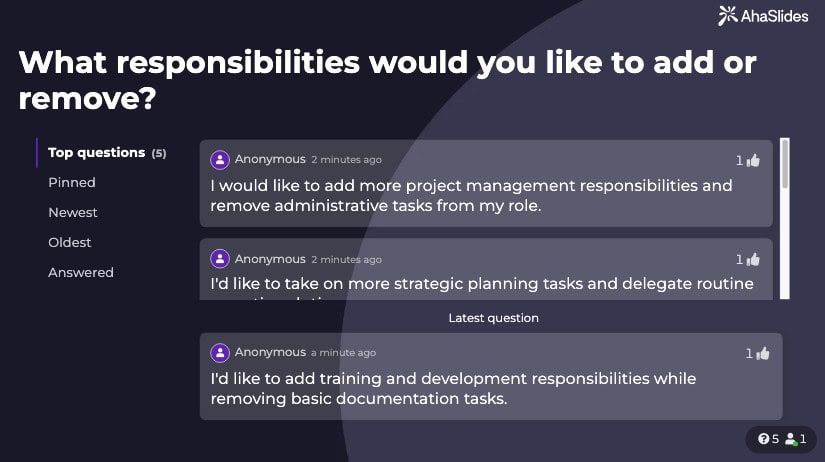
Supervisioon ja juhtimine
Küsimused:
- Kuidas hindaksite teie ja oma juhendaja vahelise suhtluse kvaliteeti?
- Kas saate oma tegevuse kohta konstruktiivset tagasisidet ja juhiseid?
- Kas teid julgustatakse oma arvamust ja ettepanekuid oma juhendajale avaldama?
- Kas tunned, et su juhendaja hindab sinu panust ja tunnustab sinu pingutusi?
- Kas olete rahul oma osakonna juhtimisstiili ja juhtimisviisiga?
- Millised juhtimisoskused oleksid teie arvates teie meeskonnas kõige efektiivsemad?
Interaktiivne lähenemine AhaSlidesiga:
- Kasutage tundliku juhendaja tagasiside saamiseks anonüümseid hinnanguskaalasid
- Esitage juhtimisstiilide valikud (demokraatlik, juhendav, transformatiivne jne) ja küsige töötajatelt, millist eelistatakse
- Võimalda otseülekandeid küsimustele ja vastustele, kus töötajad saavad esitada küsimusi juhtimisstrateegia kohta
- Loo edetabeleid: "Mis on sinu jaoks juhendaja juures kõige olulisem?" (Suhtlemine, Tunnustamine, Tagasiside, Autonoomia, Tugi)
Miks anonüümsus on oluline: Teie positsioneerimislehe kohaselt peavad personalispetsialistid looma turvalised ruumid ausaks aruteluks. Interaktiivsed anonüümsed küsitlused avalike arutelude ajal võimaldavad töötajatel juhtimist ausalt hinnata ilma karjääriprobleemideta – midagi, mida traditsiooniliste küsitlustega veenvalt saavutada on raske.
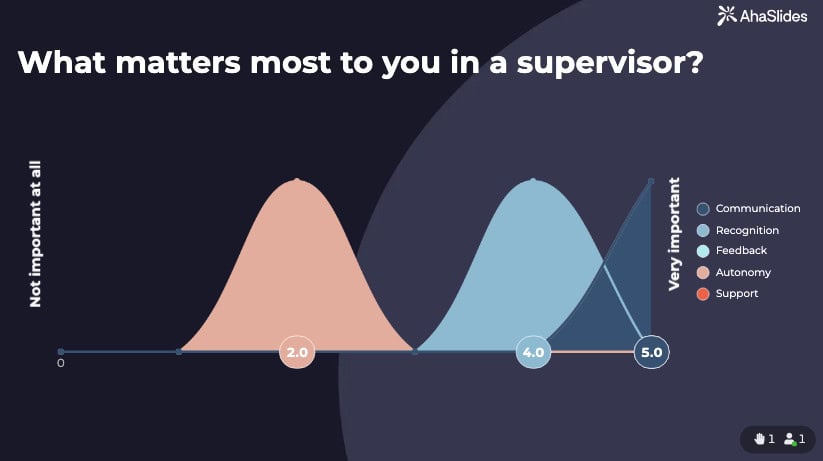
Karjääri kasv ja areng
Küsimused:
- Kas teile on tagatud võimalused professionaalseks kasvuks ja edenemiseks?
- Kui rahul olete organisatsiooni pakutavate koolitus- ja arendusprogrammidega?
- Kas usute, et teie praegune roll on kooskõlas teie pikaajaliste karjäärieesmärkidega?
- Kas teile antakse võimalusi võtta endale juhtivaid rolle või eriprojekte?
- Kas saate toetust täiendõppeks või oskuste täiendamiseks?
Interaktiivne lähenemine AhaSlidesiga:
- Küsitlus: "Milline professionaalne areng oleks teile kõige kasulikum?" (Juhtimiskoolitus, tehnilised oskused, sertifikaadid, mentorlus, edasiliikumine)
- Sõnapilv: "Kus sa näed ennast 3 aasta pärast?"
- Hinnanguskaala: "Kui toetatuna tunnete end oma karjääriarengus?" (1-10)
- Avatud küsimuste ja vastuste paneel, kus töötajad saavad küsida konkreetsete arenguvõimaluste kohta
Strateegiline eelis: Erinevalt traditsioonilistest uuringutest, kus need andmed asuvad arvutustabelis, võimaldab karjääriarengu küsimuste esitamine kvartaliülevaadete ajal otse personaliosakonnal arutada koolituseelarveid, mentorlusprogramme ja sisemisi mobiilsusvõimalusi kohe, kui vestlus on aktiivne.
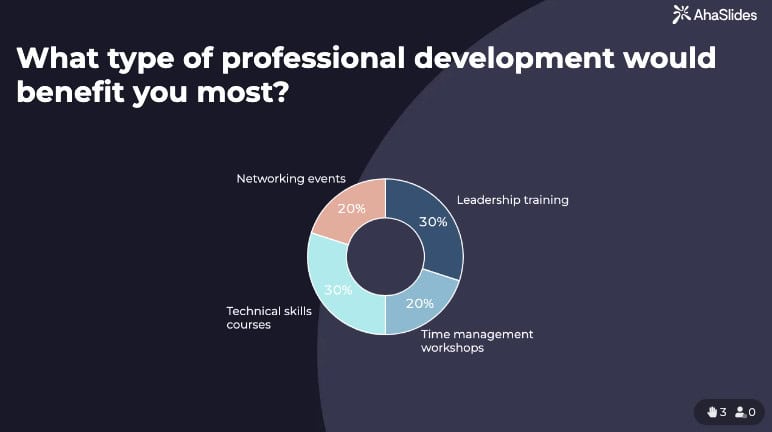
Hüvitis ja hüvitised
Küsimused:
- Kas olete rahul oma praeguse palga ja hüvitiste paketiga, sealhulgas erisoodustustega?
- Kas tunnete, et teie panust ja saavutusi premeeritakse asjakohaselt?
- Kas organisatsiooni pakutavad hüved on kõikehõlmavad ja vastavad teie vajadustele?
- Kuidas hindaksite tulemuslikkuse hindamise ja hüvitamise protsessi läbipaistvust ja õiglust?
- Kas olete boonuste, stiimulite või preemiate võimalustega rahul?
- Kas olete aastapuhkuse poliitikaga rahul?
Interaktiivne lähenemine AhaSlidesiga:
- Anonüümsed jah/ei küsitlused tundlike palgaküsimuste jaoks
- Valikvastustega küsimus: „Millised hüved on teie jaoks kõige olulisemad?“ (tervishoid, paindlikkus, õppe-eelarve, heaoluprogrammid, pensionile jäämine)
- Hinnanguskaala: "Kui õiglane on meie tasu teie panusega võrreldes?"
- Sõnapilv: "Milline üks eelis parandaks teie rahulolu kõige rohkem?"
Kriitiline märkus: Siin särab anonüümne interaktiivne küsitlus tõeliselt. Traditsioonilistes küsitlustes, mis nõuavad sisselogimisandmeid, annavad töötajad harva ausat tagasisidet töötasu kohta. Otseülekandega anonüümsed küsitlused avalike küsitluste ajal, kus vastused kuvatakse ilma nimedeta, loovad psühholoogilise turvalisuse ehtsa tagasiside saamiseks.
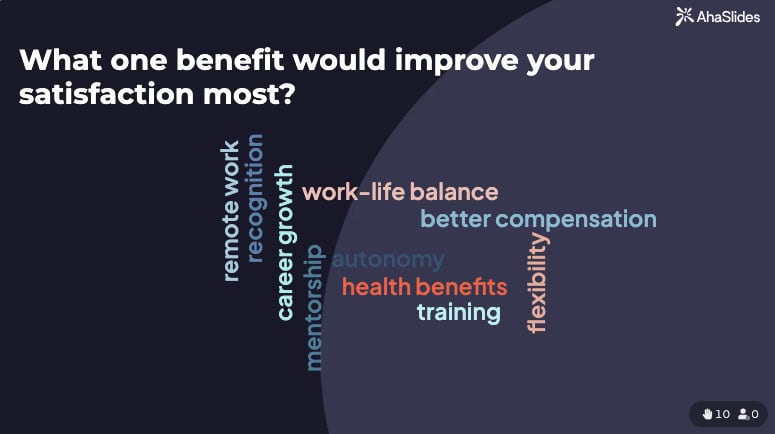
Looge oma hüvitiste tagasiside seanss →
Suhted ja koostöö
Küsimused:
- Kui hästi teete koostööd ja suhtlete oma kolleegidega?
- Kas tunnete oma osakonnas sõprust ja meeskonnatööd?
- Kas olete rahul oma kolleegide vahelise austuse ja koostöö tasemega?
- Kas teil on võimalusi suhelda kolleegidega erinevatest osakondadest või meeskondadest?
- Kas teil on mugav vajadusel kolleegidelt abi või nõu küsida?
Interaktiivne lähenemine AhaSlidesiga:
- Koostöö kvaliteedi hindamisskaalad
- Sõnapilv: "Kirjelda meie meeskonna kultuuri ühe sõnaga"
- Valikvastustega küsimus: "Kui tihti te teete osakondadevahelist koostööd?" (Iga päev, Iga nädal, Iga kuu, Harva, Mitte kunagi)
- Anonüümsed küsimused ja vastused inimestevaheliste probleemide esiletõstmiseks
Heaolu ja töö- ja eraelu tasakaal
Küsimused:
- Kui rahul olete organisatsiooni pakutava töö- ja eraelu tasakaaluga?
- Kas tunnete, et ettevõte on piisavalt toetanud stressi maandamisel ja vaimse heaolu säilitamisel?
- Kas otsite abi või ressursse isiklike või tööga seotud väljakutsete lahendamiseks?
- Kui tihti osalete organisatsiooni pakutavates terviseprogrammides või tegevustes?
- Kas teie arvates väärtustab ettevõte oma töötajate heaolu ja peab seda oluliseks?
- Kas olete rahul füüsilise töökeskkonnaga mugavuse, valgustuse ja ergonoomika osas?
- Kui hästi arvestab organisatsioon teie tervise ja heaolu vajadustega (nt paindlik tööaeg, kaugtöö võimalused)?
- Kas tunnete julgustust teha pause ja end tööst lahti ühendada, kui vajate laadimist?
- Kui sageli tunnete end tööga seotud tegurite tõttu ülekoormatuna või stressis?
- Kas olete rahul organisatsiooni pakutavate tervise- ja heaoluteenustega?
Interaktiivne lähenemine AhaSlidesiga:
- Sagedusskaalad: "Kui tihti te tunnete end stressis?" (Mitte kunagi, Harva, Mõnikord, Sageli, Alati)
- Jah/ei küsitlused heaolu toetamise kohta
- Anonüümne liugur: "Hinnake oma praegust läbipõlemise taset" (1-10)
- Sõnapilv: "Mis parandaks teie heaolu kõige rohkem?"
- Avatud küsimuste ja vastuste voor, kus töötajad saavad anonüümselt oma heaoluga seotud muresid jagada
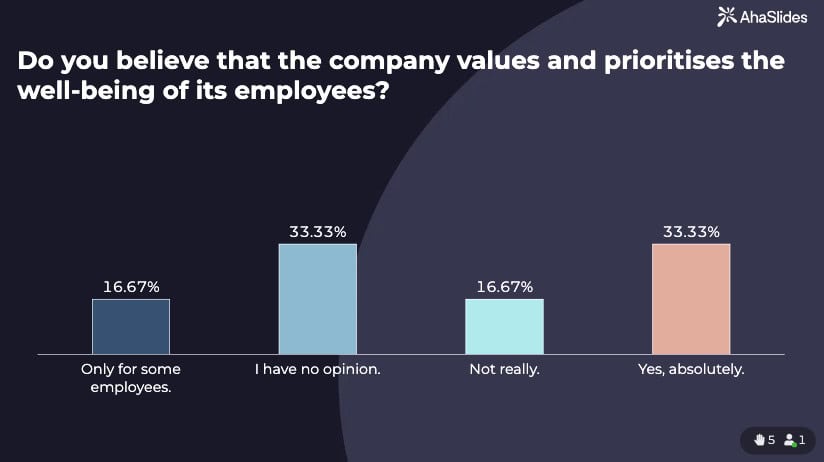
Miks see nii on? Teie positsioneerimisleht näitab, et personalispetsialistidel on raskusi „töötajate kaasamise ja tagasiside“ ning „turvalise ruumi loomisega ausaks aruteluks“. Heaolu küsimused on oma olemuselt tundlikud – töötajad kardavad läbipõlemise tunnistamisel näida nõrgad või pühendumatud. Interaktiivsed anonüümsed küsitlused kõrvaldavad selle barjääri.
Üldine rahulolu
Lõplik küsimus: 46. Skaalal 1–10, kui tõenäoliselt soovitaksite seda ettevõtet suurepärase töökohana? (Töötaja soovitusindeks)
Interaktiivne lähenemine:
- Tulemuste põhjal järelkontroll: kui skoorid on madalad, küsige kohe: "Mis on see üks asi, mida saaksime teie skoori parandamiseks muuta?"
- Kuva eNPS-i reaalajas, et juhtkond näeks koheselt meeleolu
- Kasutage tulemusi läbipaistva vestluse edendamiseks organisatsiooniliste täiustuste kohta
Kuidas AhaSlidesiga läbi viia tõhus töörahulolu uuring
1. samm: valige oma vorming
Variant A: Otseülekanne kõigi osalejate koosolekutel
- Esitage kvartalis toimuvatel avalikel aruteludel 8–12 võtmeküsimust
- Kasutage tundlike teemade puhul anonüümset režiimi
- Arutage tulemusi kohe grupiga
- Parim: usalduse loomiseks, koheseks tegutsemiseks, koostööks probleemide lahendamiseks
Variant B: Omas tempos, aga interaktiivne
- Jaga esitluslinki, millele töötajad saavad igal ajal ligi pääseda
- Lisage kõik 46 küsimust kategooriate kaupa
- Määrake täitmise tähtaeg
- Parim: Põhjalik andmekogumine, paindlik ajastus
Variant C: Hübriidlähenemine (soovitatav)
- Saatke 5–7 kriitilist küsimust omas tempos vastamiseks mõeldud küsitlustena
- Esitle tulemusi ja 3 peamist muret otse järgmisel meeskonnakoosolekul
- Kasutage reaalajas küsimusi ja vastuseid, et probleemidesse süveneda
- Parim: Maksimaalne osalus sisuka aruteluga
2. samm: seadistage oma uuring AhaSlidesis
Kasutatavad funktsioonid:
- Hindamisskaalad rahulolu taseme jaoks
- Valikvastustega küsitlused eelistusküsimuste jaoks
- Sõnapilved ühiste teemade visualiseerimiseks
- Avatud küsimused ja vastused et töötajad saaksid esitada anonüümseid küsimusi
- Anonüümne režiim psühholoogilise turvalisuse tagamiseks
- Reaalajas tulemuste kuvamine läbipaistvuse näitamiseks
Aja kokkuhoiu nipp: Kasutage AhaSlides'i tehisintellekti generaatorit, et selle küsimuste loendi põhjal kiiresti oma küsitlus luua ja seejärel oma organisatsiooni konkreetsetele vajadustele kohandada.
3. samm: edastage eesmärk
Enne küsitluse alustamist selgitage:
- Miks te seda teete (mitte ainult "sest on aeg iga-aastasteks uuringuteks")
- Kuidas vastuseid kasutatakse
- Et anonüümsed vastused on tõeliselt anonüümsed
- Millal ja kuidas tulemusi jagate ja tegutsete
Usalduse loomise skript: „Me tahame aru saada, kuidas te siin töötamise suhtes siiralt suhtute. Kasutame anonüümseid interaktiivseid küsitlusi, sest teame, et traditsioonilised küsitlused ei jäädvusta teie ausat tagasisidet. Teie vastused kuvatakse ilma nimedeta ja arutame tulemusi koos, et ühiselt lahendusi välja töötada.“
4. samm: otseülekanne (vajadusel)
Koosoleku struktuur:
- Sissejuhatus (2 minutit): Selgitage eesmärki ja anonüümsust
- Küsitluse küsimused (15-20 min): Esitage küsitlusi ükshaaval, näidates reaalajas tulemusi
- Arutelu (15–20 minutit): Tegelege koheselt peamiste muredega
- Tegevuskava koostamine (10 minutit): Pühenduge konkreetsetele järgmistele sammudele
- Järelküsimused ja vastused (10 minutit): Anonüümsete küsimuste jaoks avatud põrand
Pro tip: Kui ilmnevad tundlikud tulemused (nt 70% hindab juhtimiskommunikatsiooni halvaks), tunnistage neid kohe: „See on oluline tagasiside. Arutagem, mida „halb kommunikatsioon” teie jaoks tähendab. Kasutage küsimuste ja vastuste rubriiki, et jagada anonüümselt konkreetseid näiteid.“
5. samm: tegutse tulemuste põhjal
Siin loovad interaktiivsed küsitlused konkurentsieelise. Kuna olete reaalajas vestluste käigus tagasisidet kogunud:
- Töötajad on juba tulemusi näinud
- Oled avalikult lubanud tegusid
- Järeltegevus on oodatav ja nähtav
- Usaldus tekib siis, kui lubadusi peetakse
Tegevuskava mall:
- Jaga üksikasjalikke tulemusi 48 tunni jooksul
- Tuvastage 3 peamist parendusvaldkonda
- Moodustage lahenduste väljatöötamiseks töörühmi
- Teatage edusammudest igakuiselt
- Kordusküsitlus 6 kuu pärast edusammude mõõtmiseks
Miks interaktiivsed küsitlused toimivad paremini kui traditsioonilised vormid
Vastavalt teie organisatsiooni vajadustele peate tegema järgmist:
- "Mõõda töötajate kaasatust personalijuhtimise algatuste ajal"
- "Hõlbustada anonüümseid küsimuste ja vastuste sessioone linnavalitsustes"
- "Koguge töötajate arvamusi sõnapilvede ja reaalajas küsitluste abil"
- "Looge turvaline ruum ausaks aruteluks"
Traditsioonilised küsitlustööriistad nagu Google Forms või SurveyMonkey ei suuda sellist kogemust pakkuda. Need koguvad andmeid, aga ei loo dialoogi. Nad koguvad vastuseid, aga ei loo usaldust.
Interaktiivsed platvormid nagu AhaSlides muudavad tagasiside kogumise bürokraatlikust harjutusest sisukaks vestluseks kus:
- Töötajad näevad, et nende häälel on reaalajas kaalu
- Juhid näitavad üles kohest pühendumust kuulamisele
- Anonüümsus kõrvaldab hirmu, samas kui läbipaistvus loob usaldust
- Arutelu viib koostööl põhinevate lahendusteni
- Andmetest saab vestluse alustaja, mitte sahtlis vedelev aruanne
Võtme tagasivõtmine
✅ Töörahulolu uuringud on strateegilised tööriistad, mitte administratiivsed märkeruudud. Need näitavad, mis mõjutab kaasatust, klientide hoidmist ja tulemusi.
✅ Interaktiivsed küsitlused annavad paremaid tulemusi kui traditsioonilised vormid – kõrgem vastamismäär, ausam tagasiside ja kohesed aruteluvõimalused.
✅ Anonüümsus pluss läbipaistvus loob psühholoogilise turvatunde, mida on vaja siira tagasiside saamiseks. Töötajad vastavad ausalt, kui nad teavad, et vastused on anonüümsed, kuid näevad, et juhid tegutsevad.
✅ Selle juhendi 46 küsimust hõlmavad kriitilisi aspekte tööga rahulolu: keskkond, vastutus, juhtimine, areng, tasustamine, suhted ja heaolu.
✅ Reaalajas tulemused võimaldavad kohe tegutseda. Kui töötajad näevad oma tagasisidet koheselt visualiseerituna ja avatult arutatuna, tunnevad nad, et neid kuulatakse, mitte ei küsitata lihtsalt üle.
✅ Tööriistad on olulised. Platvormid nagu AhaSlides, mis pakuvad reaalajas küsitlusi, sõnapilvi, anonüümseid küsimusi ja vastuseid ning reaalajas tulemuste kuvamist, muudavad staatilised küsimustikud dünaamilisteks vestlusteks, mis soodustavad organisatsioonilisi muutusi.
viited:




